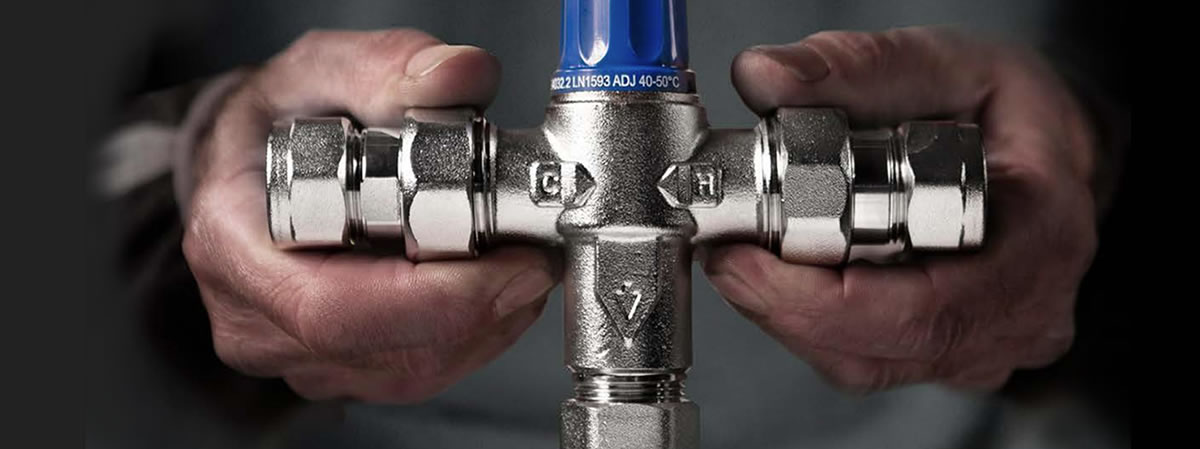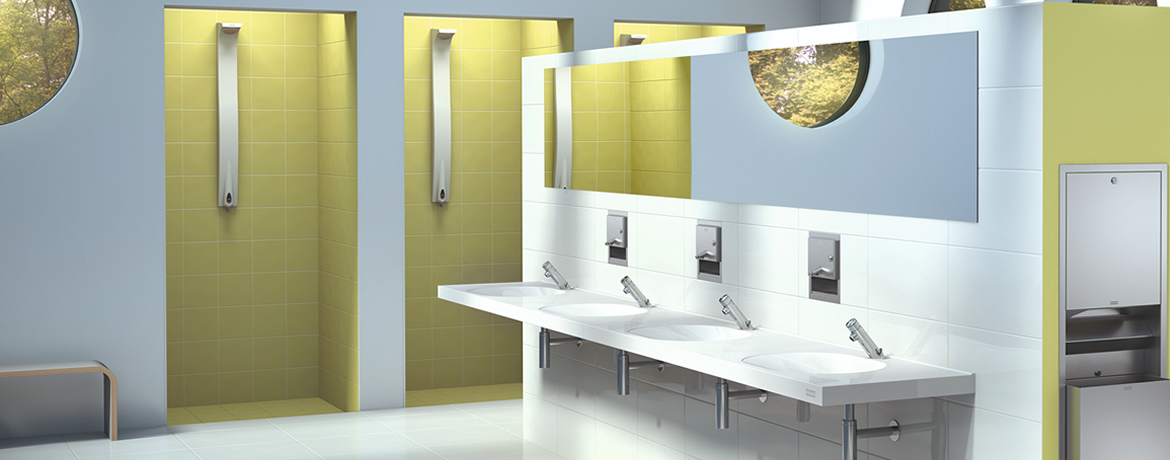Stainless Steel Benefits, Advanced Care and Maintenance in Commercial Washrooms

In commercial washrooms, stainless steel is a popular material for fixtures, fittings and accessories not least due to its aesthetic appeal and choice of finishes. But also due to its resistance to corrosion and inherent strength.
When stainless steel is clean nothing quite beats its stylish, contemporary and executive look. The timeless style of the silver reflective finish is also immune to changes in design and fashion.
Often all that is required to give a washroom a facelift and avoid the expense of a full washroom refurbishment project is the addition of some carefully selected, quality stainless steel accessories. It also has the benefit of being more hygienic than other surface finishes. Stainless steel accessories are often manufactured from forming or bending larger sheets of metal into shape, germs then have fewer nooks and surface imperfections in which to breed and escape the attention of cleaning. These simple smooth shapes also have the benefit of requiring a lower concentration of cleaning fluid to achieve the same cleanliness as other surfaces.
Everything from cubicle fittings, electric hand dryers, toilet pans, soap dispensers to toilet door lock mechanisms are manufactured from stainless steel. But without proper maintenance and cleaning stainless steel can suffer from everything from non-permanent watermark staining to severe and possibly permanent discolouration.
So we cannot assume stainless steel is completely maintenance free. And certainly in a commercial washroom setting stainless steel surfaces will need regular cleaning, at least for hygiene reasons.
Stainless steel washroom accessories often come in a choice of finishes with the two most popular being brushed (sometimes called satin), or polished stainless steel finishes. While both finishes are a result of polishing the metal, a 'polished' surface will be finished with a much finer grit during the final polishing process, until a highly reflective finish is achieved.
Brushed/satin stainless shows much less marking from deposits, water and grease due to the fact it has much more surface abrasion and less reflective properties allowing for deposits to be somewhat disguised by the dull finish compared to its polished counterpart. Manufacturers such as Franke with their Xinox range and InnoxPlus coating are also experimenting with nano-particle coatings that are said to prevent and reduce the appearance of marks even longer.
For standard washroom cleaning and hygiene purposes, your normal schedule and commercial cleaning fluid will still be suitable to clean your stainless steel accessories and fittings, but it is essential to use a cleaning fluid specified for use on stainless steel. Or at least a cleaning fluid not explicitly specified as not for use on stainless steel.
Care must always be taken to adhere to the manufacturer’s instructions. Deposits and other non-permanent marks can quite easily be cleaned from stainless steel simply with a damp microfiber cloth, though care must be used to dampen the cloth with clean water and only use areas of the cloth that are not dirty. This could be preceded by a spray from a sanitizer to prevent the build-up of germs. Particularly important on accessories that may be regularly touched such as locks, door handles and dispensers.
If you have read our previous post "What products should I use to clean my stainless steel washroom dispensers" FAQ you will not need to be reminded of this.
But how should you care for stainless steel with semi-permanent marking?
Below are the most common types of heavy soiling of stainless steel you will encounter in a commercial toilet environment. But please note all the recommendations below should be followed by a wipe down with a clean damp cloth to remove trace deposits of any cleaning product used after the stainless steel has been satisfactorily cleaned. And then a wipe with a clean dry cloth to prevent water marks.
Ensure to use all cleaning chemicals as directed by the manufacturer. All advice on cleaning stainless steel is given in good faith but without responsibility. If in doubt refer to manufacturer recommendations.
Routine cleaning and light soiling
A soap or detergent dilute (1%) ammonia suitable for stainless steel, applied with a clean cloth, wiped down with a clean damp cloth and then dried with a dry cloth, microfiber cloths are best for the cleaning stainless steel and other highly reflective surfaces.
Fingerprints
Marks from fingerprints are left behind on stainless steel from the grease naturally present on our skin, this grease effects the refraction of light and on shiny surfaces such as mirrors and stainless this causes the unsightly look. Fingerprints can be easily removed with warm water and for stubborn grease marks a hydrocarbon solvent/degreaser. This is often a common problem in commercial washrooms and public restrooms due to the frequency of use.
Light Discolouration, Water Marking or Light Rust Staining
Watermarking often appears as a pale white film or pale white rings tarnishing the surface of stainless steel. It occurs when water is allowed to dry (evaporate) off of stainless steel, and if left these water spots can be quite stubborn to remove. Rust staining can occur from the transfer of dust particles from other metals to the stainless steel finish, but by its very nature stainless steel will not rust itself. Watermarking is more prevalent in a commercial washroom environment simply due to the number of wet hands touching surfaces and splashes from over-exuberant taps.
Both types of deposits can be cleaned with a mild polishing cream such as Cif. Franke and Berghoff are two major European manufacturers of stainless steel equipment that both produce own branded cream cleaning fluids, expressly for use on their products. Showing that this is probably the best cleaning method preferred by manufacturers.
Ensure to wipe all traces of residue off after cleaning and dry with a clean cloth to avoid future marking. Do not use polishing/cleaning creams with abrasive additions or chloride in this will damage the surface of the item being cleaned.
Paint and Graffiti
Anti-vandal sanitary ware is a popular choice in public toilets and commercial washrooms in hospitals and secure accommodations and it is often manufactured in stainless steel. Aside from the strength benefits that make is suitable for such environments, it is also resistant to other kinds of vandalism including graffiti. While paint will adhere to the stainless steel surface it will not penetrate and absorb into the metal. Therefore cleaning is quite straightforward.
Alkaline or solvent paint strippers can be used and with the use of a soft nylon or bristled brush agitate the surface of the paint, which will lift and cut the solvent into the paint. By following this process you will have a clean stainless steel surface in no time with no lasting damage to the surface of the metal.
Badly Neglected Surfaces with Accumulated Grime
In this circumstance and exhausting all the options above, then you may have to use an abrasive paste, such as those used in the auto body finishing industry. This process will alter the finish of the surface of stainless steel and so should be considered a last resort. Especially in commercial washrooms where the stainless steel is present not just for its other benefits but its aesthetics.
A suitable polishing compound could be T-Cut or similar, the auto body industry has many different abrasive polishing pastes of varying grits, the finest grit possible should be selected to reduce the amount of damage to the surface of the metal. You can use a courser grit later if need be. Due to the destructive nature of this cleaning method, it is best to work up the grits to minimise damage. You will then need to work down the grits after removing the accumulated grime, in order to restore the surface finish as best you can by hand.
However, any abrasive paste may brighten dull finished stainless steel. And the whole surface may need to be treated to maintain a uniform finish to the metal.
Stainless steel is an excellent choice for commercial washroom fixtures and fittings. With the correct cleaning and maintenance, it will provide years of use whilst also looking stylish and contemporary. Flexible and versatile stainless steel accessories will look great in everything from public toilets to executive level washrooms with the very little risk of ever going out of fashion or looking dated.
Got a question? Get in touch






